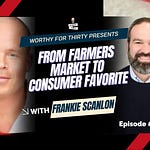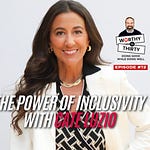How to Build a Purpose-Driven Brand That Disappears Off the Shelf
In a crowded market full of fleeting trends and artificial flavors, how do you build a product that commands premium quality, which correlates with deep, immediate customer loyalty?
Meet Amit and Marcin, the founders of Mission Craft Cocktails. They aren’t career bartenders or spirits industry veterans; they are simply two friends who saw a massive quality gap in the $1.8 billion Ready-to-Drink (RTD) cocktail category. Their solution wasn’t just to make a better product—it was to build a better business model, making social impact a core financial pillar of their company.
In this powerful episode on the Worthy for Thirty podcast we dive deep with the Mission Craft Cocktails founders to uncover the non-negotiable business strategies that scaled their award-winning, quality-first, and mission-driven brand. This isn’t just a story about cocktails; it’s a masterclass in market disruption and building a sustainable give-back model. Make this clear and concise
The founders ‘why’ is more impactful than the ‘how.’ Marcin and Amit’s upbringing and being immigrants to the U.S. made this mission even more intrinsic to the brand.
1. The ‘5% Revenue’ Strategy: Turning Purpose into a Non-Negotiable COGS
Most companies that donate use a percentage of profit—a figure that fluctuates and can be easily zeroed out in lean times. Mission Craft Cocktails flipped the script by dedicating 5% of all top-line revenue to local food banks.
The How: By baking the 5% donation into their pricing and financial model from day one, they treated “impact” as a fixed, non-negotiable Cost of Goods Sold (COGS). This provided immediate transparency and confidence to their supply chain, partners, and customers.
🔑 Takeaway: Do not treat your social mission as a marketing budget or a variable expense. Integrate your purpose into your financial structure. This approach drastically increases the trust currency of your brand, as customers know their purchase guarantees a tangible result (e.g., they provided over 26,000 meals in 2023 and have now exceeded over 600K meals donated in partnership with Feeding America. 🤯
Relatable Example: Similar to Patagonia dedicating 1% of its sales to environmental causes, making the commitment public and fixed creates an unparalleled competitive moat based on ethics.
2. The Outsider Advantage: Using Maniacal Focus to Disrupt Quality
Amit and Marcin are self-proclaimed “outsiders” to the spirits world. Instead of learning industry shortcuts, they focused relentlessly on solving the consumer pain point: poor quality in RTD cocktails.
The How: They benchmarked their products not against other bottled drinks, but against the gold standard of high-end bar cocktails. This required two years of R&D to perfect using only locally-sourced California ingredients and authentic spirits (like Tequila from Jalisco, Mexico), refusing to use artificial stabilizers or flavors.
🔑 Takeaway: When entering a competitive, entrenched market, don’t just innovate on price or packaging—innovate on core quality that competitors have neglected due to legacy processes or institutional inertia. An outsider’s perspective often sees the simplest, yet most critical, area for improvement.
Relatable Example: Think of Warby Parker (optical industry) or Dollar Shave Club (razor industry). They weren’t constrained by established distribution or manufacturing methods, allowing them to deliver superior value and convenience where incumbents were comfortable.
3. Proceduralizing Authenticity for Scale
The challenge of any artisanal product is maintaining integrity when scaling from a small kitchen batch to large-volume bottling. Mission Craft Cocktails had to ensure the complex flavor profile of a cocktail like the Mai Tai remained perfect in a 5,000-liter vat.
The How: They invested significant time in reverse-engineering their complex recipes into repeatable, industrial processes that strictly preserved the integrity of the fresh ingredients (like lime juice and locally-sourced orange liqueur). This required intense vendor vetting and a deep understanding of preservation science.
🔑 Takeaway: Successful scaling is predicated on turning art into science. For executives, this means proceduralizing your core differentiator (be it service, quality, or speed) so that it survives the transition to mass market. Authenticity must be defined by process, not just intent.
Relatable Example: The entire history of Starbucks is a lesson in scaling an artisanal “third place” coffee experience globally while attempting to maintain procedural quality standards for the perfect espresso shot.
4. Leveraging Third-Party Validation to De-Risk Partnership
When entering a market without existing brand recognition, external validation—like winning major industry awards—is crucial for accelerating trust among retailers and distributors.
The How: Marcin & Amit secured prestigious Double Gold awards for multiple products (Margarita, Mai Tai, Old Fashioned) early in Mission Craft Cocktail’s launch phase. They then use this objective critical acclaim, combined with their strong give-back mission, to secure immediate deals with major national retailers (like Total Wine & More).
🔑 Takeaway: For a disruptive product, awards and endorsements are not just for marketing; they are essential due diligence tools for your partners. Invest in seeking high-status validation to drastically reduce the perceived risk of stocking or distributing your novel product.
Relatable Example: The early success of YETI coolers was driven less by direct-to-consumer marketing and more by winning endorsements from professional fishermen and outdoor guides, lending instant, credible authority to a premium-priced product.
5. The Dual-Customer Focus: Serving the Consumer and the Community
A purpose-driven business successfully recognizes and markets to two distinct “customers”: the individual consumer making the purchase and the community benefiting from the purchase.
The How: Mission Craft Cocktails’ marketing effectively speaks to both needs: convenience and quality for the drinker, and direct social impact (meals funded) for the socially-conscious shopper. This dual narrative completely changes a discretionary, transactional purchase into a values-based, repeatable act of giving.
🔑 Takeaway: Design your product experience and marketing to explicitly communicate the impact metric (meals funded, trees planted, etc.) rather than just the donation percentage. This engages the customer as a collaborator in the mission, drastically improving retention and word-of-mouth growth.
Relatable Example: Bombas socks, with their “one pair purchased = one pair donated” model, built an enormous brand around the dual satisfaction of receiving a high-quality product while actively addressing homelessness.









